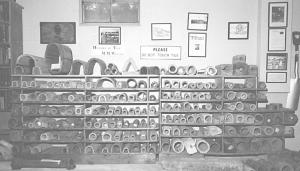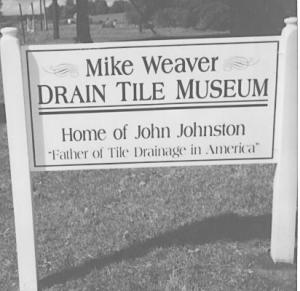1996 - Volume #20, Issue #3, Page #19
[ Sample Stories From This Issue | List of All Stories In This Issue | Print this story
| Read this issue]
Drain Tile Expert
 |
 |
For many years Weaver was an engineer with the Soil Conservation Service. Working in an area where drainage tile had been widely used for over 150 years, he learned about John Johnston, the "father of tile drainage in America." Weaver started collecting drain tiles over 40 years ago and wrote a detailed history of drain tile in the 1960's. About two years ago he started a museum to show off his collection and showcase the origins of what he considers one of the most important developments in the history of agriculture.
John Johnston arrived in the U.S. in May 1821 from Scotland and purchased his first farm - 320 poorly drained acres - with $1,200 in borrowed money. He had learned about field drainage in Scotland but drain tiles were rare in the U.S. So in 1835 he sent a message to friends in Scotland, requesting two drain tile "patterns". Then he had a friend start reproducing the clay tiles in volume and he laid the tiles in trenches across his farm and quickly became an object of local ridicule.
He had the last laugh. His fields, containing 72 miles of drain tile, were soon producing twice as many bushels of wheat per acre as the undrained fields of his neighbors. Word of what drain tiles could do for wet farmland soon began to spread.
Weaver's museum has one of the two original tiles sent from Scotland. The other one is in the Henry Ford Museum in Dearborn, Mich., which is a sore point for Weaver because as far as he knows they've never put it, or any of the other 46 tiles he sent them, on display. When he recently asked about getting them back, they told him they weren't even aware that they had them. He still hopes to get them back.
There are over 350 different types of tile in his collection, including a number of other tiles dug up from Johnston's farmland. Most early tiles were round or horseshoe-shaped, and about 15 in. long. They were buried 2 or 3 ft. deep lying end to end in a trench. Water entered the tile lines through the spaces between the sections.
Weaver's collection includes tiles made of wood, cement, stone, and glass. There's a drain tile from ancient Turkey that may be more than 3,000 years old. There's an-other drain tile made by German prisoners of war at a factory in Ohio during World War II. The prisoners scratched a swastika on it when no one was looking.
Weaver's 350-page book about Johnston and the history of drain tiles sells for $15.
Contact: FARM SHOW Followup, Mike Weaver, 1332 Rt. 96, Waterloo, N.Y. 13165 (ph 315 539-3963).

Click here to download page story appeared in.

Click here to read entire issue
To read the rest of this story, download this issue below or click here to register with your account number.




